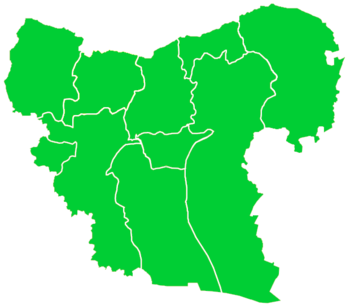Tell Aran
| Tell Aran تل عرن | |
|---|---|
| Village | |
 Tell Aran | |
| Coordinates: 36°7′23″N 37°20′13″E / 36.12306°N 37.33694°E | |
| Country |
|
| Governorate | Aleppo |
| District | Al-Safira |
| Subdistrict | Al-Safira |
| Population (2004 census)[1] | |
| • Total | 17,767 |
| Time zone | EET (UTC+2) |
| • Summer (DST) | EEST (UTC+3) |
Tell Aran (Arabic: تل عرن; also spelled, Tell Arn; ancient Arne) is a town in northern Syria, administratively part of the al-Safira District of the Aleppo Governorate, located southeast of Aleppo close to Sabkhat al-Jabbul. Nearby localities include Tell Hasil, al-Nayrab and Tell Shughayb to the northwest and al-Safira to the southeast. According to the Syria Central Bureau of Statistics (CBS), Tell Aran had a population of 17,767 in the 2004 census.[1] The town is famous for its grapes, vineyards and gardens.[2]
History
The archaeological mound is the largest tell in the Aleppo region[3] and measures around 30 metres (98 ft) in height and 150 metres (490 ft) in width. It is believed to be the site of the ancient Iron Age settlement of Arne.[4] Arne was first inhabited by the Arameans,[5] and served as the first royal capital of the Aramaean kingdom of Bet-Gus.[4] The kingdom of Bet-Gus stretched from the Azaz area in the north to Hamath in the south,[6] and was established by Gus of Yahan in the 9th-century BCE.[7]
In Assyrian records, the city is observed as the seat of Arame, son of the founder of the kingdom. It was sacked by the Assyrian king Shalmaneser III in 849 BC during one of his campaigns in the west, as attested by a bronze band found at Balawat. After the city's sacking, Arpad (modern Tell Rifaat) became the capital of the kingdom of Bet-Gus.[4] The modern site still contains the remains of massive mud-brick walls measuring 20 metres (66 ft) in width. Excavations at the site produced pottery corresponding to human occupation during the Iron Age II, but not Iron Age I. Tell Aran is also possibly the site of a major battle between the Egyptian king Thutmose III and a Mitannian army which ended with a crushing defeat to the king of Mitanni.[5]
References
Bibliography
- Bryce, Trevor (2009). The Routledge Handbook of The People and Places of Ancient Western Asia: The Near East from the Earky Bronze Age to the fall of the Persians Empire. Routledge. ISBN 9781134159086.
- Lipiński, Edward (2000). The Aramaeans: Their Ancient History, Culture, Religion. Peeters Publishers. ISBN 9789042908598.
- Le Strange, Guy (1890). Palestine Under the Moslems: A Description of Syria and the Holy Land from A.D. 650 to 1500. Alexander P. Watt for the Committee of the Palestine Exploration Fund.

